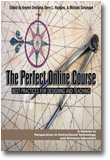
The Perfect Online Course
Best Practices for Designing and Teaching
Edited by:
Anymir Orellana, Nova Southeastern University
Terry L. Hudgins, Nova Southeastern University
Michael Simonson, Nova Southeastern University
A volume in the series: Perspectives in Instructional Technology and Distance Education. Editor(s): Charles Schlosser, Nova Southeastern University. Michael Simonson, Nova Southeastern University.
Published 2009
The Perfect Online Course: Best Practices for Designing and Teaching was edited under the assumption that a perfect online course can be delivered following different instructional methods and models for design and for instruction, and by implementing different teaching or instructional strategies. Such methods, models, and strategies are framed within quality educational guidelines and must be aimed towards attaining the online course’s learning goals.
The book seeks to make a contribution to the existing body of literature related to best practices and guidelines for designing and teaching distance courses, specifically online education. The process of selecting works suitable for this compilation included an extensive review of the journals Quarterly eview of Distance Education and Distance Learning. The book begins by covering literature related to general approaches and guidelines, continues with proposed methods and models for designing and instruction, and ends with instructional strategies to achieve engagement through interaction. The book is divided into four independent, yet interrelated, parts and a concluding section: Part I: Introduction; Part II: Best Guidelines and Standards; Part III: Best Instructional Methods and Models; Part IV: Best Engagement Strategies; and the concluding section, And Finally…, with words from Simonson who delineates the structure of a perfect online course.
CONTENTS
Preface: In Search of Perfection, Anymir Orellana and Terry L. Hudgins. PART I: INTRODUCTION. We Need a Plan: An Instructional Design Approach for Distance Education Course, Michael Simonson and Charles Schlosser. Does it Matter? Analyzing the Results of Three Different Learning Delivery Methods, William N. Chernish, Agnes L. DeFranco, James R. Lindner, and Kim E. Dooley. PART II: BEST GUIDELINES AND STANDARDS. In Search of Quality: An Analysis of e-Learning Guidelines and Specifications, Atsusi Hirumi. Learning Online: Adapting the Seven Principles of Good Practice to a Web-Based Instructional Environment, Christine K. Sorensen and Danilo M. Baylen. Instructors’ Self-Perceived Pedagogical Principle Implementation in the Online Environment, Jinsong Zhang and Richard T. Walls. Key Instructional Design Elements for Distance Education, Lihua Zheng and Sharon Smaldino. Class Size and Interaction in Online Courses, Anymir Orellana. What Works: Student Perceptions of Effective Elements in Online Learning, Marcy Reisetter and Greg Boris. Design and Implementation of a Web-Based Learning Environment: Lessons Learned, Alaa Sadik and Sorel Reisman. A Framework for Analyzing, Designing, and Sequencing Planned e-Learning Interactions, Atsusi Hirumi. Designing Effective e-Learning: Guidelines for Practitioners, Angelene C. McLaren. PART III. BEST INSTRUCTIONAL METHODS AND MODELS. An Analysis of Team vs. Faculty-Based Online Course Development: Implications for Instructional Design, Mark Hawkes and Dan O. Coldeway. Getting it Right Gradually: An Iterative Method for Online Instruction Development, Douglas A. Kranch. Towards a Person-Centered Model of Instruction: Can an Emphasis on the Personal Enhance Instruction in Cyberspace? Christopher Miller and Joan M. Mazur. Enhancing Web-Based Instruction Using a Person-Centered Model of Instruction, Christopher T. Miller. Evaluating College Students’ Efforts in Asynchronous Discussion: A Systematic Process, Dave S. Knowlton. Pragmatic Methods to Reduce Dishonesty in Web-Based Course, Newell Chiesl. Organizing Instructional Content for Web-based Courses: Does a Single Model Exist? Joi L. Moore, Richard E. Downing, and David L. York. An Instructional Design Approach for Effective Shovelware: Modifying Material for Distance Education, Gary R. Morrison and Gary J. Anglin. Investigating the Use of Advance Organizers as an Instructional Strategy for Web-Based Distance Education, Baiyun Chen, Atsusi Hirumi, and Ning Jackie Zhang. Streamlining the Online Course Development Process by Using Project Management Tools, M’hammed Abdous and Wu He. The Learning Contract Process: Scaffolds for Building Social, Self-Directed Learning, Naomi R. Boyer. PART IV: BEST ENGAGMENT STRATEGIES. Interaction in Online Learning Environments: A Review of the Literature, Constance E. Wanstreet. Interaction Online: A Reevaluation, John Battalio. Online Learner’s Preferences for Interaction, Pamela T. Northrup. Learner Support Needs in Online Problem-Based Learning, Steve Wheeler. Deep Learning: The Knowledge, Methods, and Cognition Process in Instructor-Led Online Discussion, Byron Havard, Jianxia Du, and Anthony Olinzock. It’s The Same Only Different: The Effect the Discussion Moderator has on Student Participation in Online Class Discussions, Vance A. Durrington and Chien Yu. Does Sense of Community Matter? An examination of Participants’ Perception of Building Learning Communities in Online Courses, Xiaonjing Liu, Richard J. Magjuka, Curtis J. Bonk, and Seung-hee Lee. CONCLUSION. And Finally ... Designing the “Perfect” Online Course, Michael Simonson. About the Authors.
MORE INFORMATION
> Reviewed in American Journal of Distance Education. Download the complete review here (PDF)
-
Paperback978-1-60752-120-4
Web price: $62.04 (Reg. 72.99)
-
Hardcover978-1-60752-121-1
Web price: $80.64 (Reg. 94.87)
- eBook9781607522058

-
 Beyond the Online Course
Leadership Perspectives on e-Learning
Beyond the Online Course
Leadership Perspectives on e-Learning
-
 Distance Education
Statewide, Institutional, and International Applications of Distance Education, 2nd Edition
Distance Education
Statewide, Institutional, and International Applications of Distance Education, 2nd Edition
-
 Distance Education
Statewide, Institutional, and International Applications of Distance Education
Distance Education
Statewide, Institutional, and International Applications of Distance Education
-
 Learning From Media 2nd Ed.
Arguments, Analysis, and Evidence
Learning From Media 2nd Ed.
Arguments, Analysis, and Evidence
-
 Real-Life Distance Education
Case Studies in Practice
Real-Life Distance Education
Case Studies in Practice
-
 Research on Course Management Systems in Higher Education
Research on Course Management Systems in Higher Education
-
 Trends and Issues in Distance Education 2nd Edition
International Perspectives
Trends and Issues in Distance Education 2nd Edition
International Perspectives

